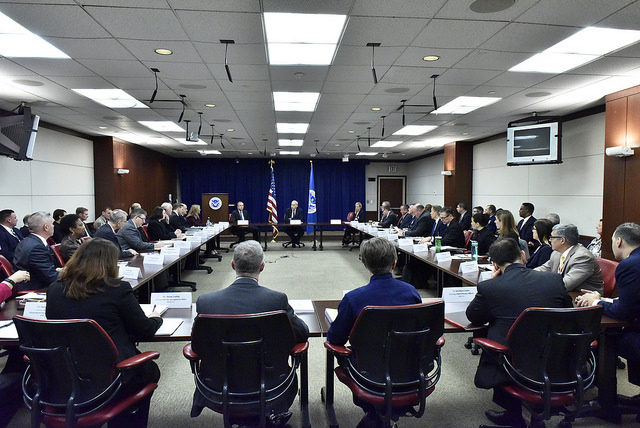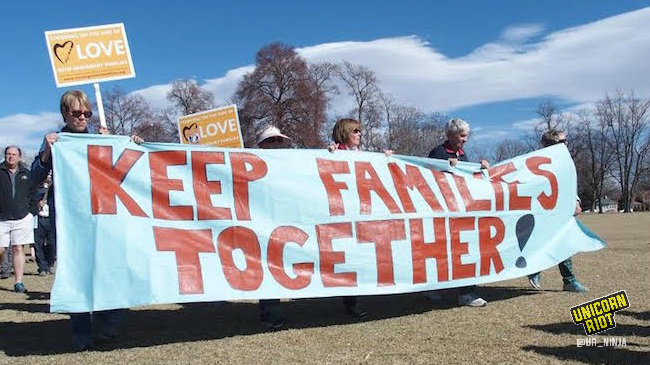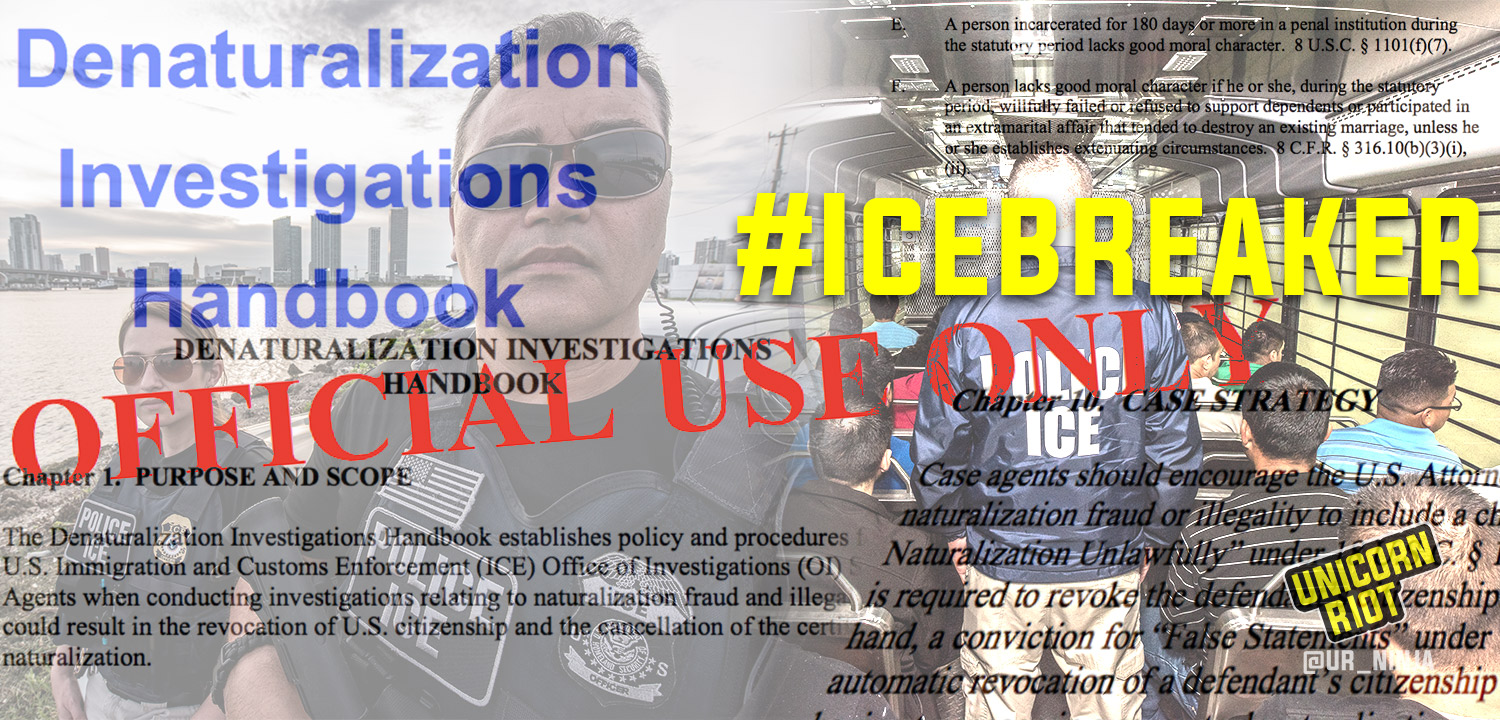Icebreaker Pt 1 – Secret Homeland Security ICE/HSI Manual for Stripping US Citizenship
A confidential manual, which Unicorn Riot has obtained in full, guides the US Department of Homeland Security’s little-known investigative arm, Homeland Security Investigations, in targeting and stripping citizenship from naturalized foreign-born Americans.
This is the first story in Unicorn Riot’s “Icebreaker” series, which aims to promptly release this information in complete form, with your support. An anonymous source provided Unicorn Riot with Homeland Security Investigations Special Agent handbooks covering 22 years of confidential internal federal law enforcement policies.
#Icebreaker Series - Unicorn Riot series on ICE policy manuals
- Icebreaker Pt 1 – Secret Homeland Security ICE/HSI Manual for Stripping US Citizenship (Feb. 14, 2018)
- Icebreaker Pt 2 – Confidential Homeland Security Asset Forfeiture and Search and Seizure Handbooks (Feb. 22, 2018)
- Icebreaker Pt 3 – Confidential Homeland Security Fugitive and Compliance Enforcement Handbooks (Feb. 28, 2018)
- Icebreaker Pt 4 – Homeland Security Special Agent On-the-Job Training Manual (Apr. 27, 2018)
- Icebreaker Pt 5 – Confidential Homeland Security Undercover Operations Handbook (Jun. 22, 2018)
- Icebreaker Pt 6 – Leaked ICE Special Response Team Handbook for Planning and Executing Armed Raids (Sept. 18, 2019)
- Icebreaker Pt 7 - ICE Case Management Handbook Based on Federal Law Enforcement "System of Systems” (Dec. 13, 2019)
- Icebreaker Pt 8 – Leaked ICE Handbooks for T and U Visa Application Investigations (Dec. 18, 2019)
- Icebreaker Pt 9 – Leaked Interrogation and Arrest ICE Manuals (Jan. 1, 2020)
- Icebreaker Pt 10 – Leaked ICE Agent Private Bill and Commercial Trade Fraud Investigation Handbooks (Jan. 4, 2020)
- Icebreaker Pt 11 – Bush/Clinton Era Customs Investigators Manuals (Feb. 13, 2020)
Update 2/23: See also Icebreaker Pt 2 – Confidential Homeland Security Asset Forfeiture and Search and Seizure Handbooks, and articles by Eoin Higgins in The Intercept: How ICE seeks to strip citizenship & how the search and seizure handbook helps avoid Constitutional challenges. Icebreaker Part 3 covers Fugitive and Compliance Enforcement Handbooks.
Jennifer Chang Newell, a managing attorney with the American Civil Liberties Union Immigrants’ Rights Project, told Unicorn Riot:
“It’s beyond troubling that immigration authorities are focusing their resources on taking away citizenship from individuals who naturalized over a decade ago. The denaturalization efforts are in line with the Trump Administration’s policies stripping DACA and Temporary Protected Status from hundreds of thousands of immigrants who have been contributing to this country for years.” — Jennifer Chang Newell, managing attorney with the ACLU Immigrants’ Rights Project
The Denaturalization Investigations Handbook is dated January 15, 2008 and designated OFFICIAL USE ONLY. It includes information an agent would consult on whether to attempt stripping citizenship, and the intricacies of building up the case against a naturalized citizen.
Denaturalization, explained in the Handbook as the “revocation of naturalization…the revoking and setting aside of the order admitting a person to citizenship and canceling the certificate of naturalization” hit the news in January 2018 with the case of Baljinder Singh, also known as Davinder Singh.
The Department of Justice announced Singh’s citizenship was revoked because, the government alleged, he provided false information. The government promised this was just the first denaturalization in “Operation Janus”, a Department of Homeland Security initiative to “investigate and seek denaturalization proceedings against those who obtained citizenship unlawfully.”
Since 2008 (when the handbook was written) the legal environment has changed slightly: In a June 2017 US Supreme Court ruling, Maslenjak vs United States found that “the Government must establish that the defendant’s illegal act played a role in her acquisition of citizenship“, which wasn’t the case for Maslenjak. The Associated Press noted, “the court rejected the position taken by the Trump administration that even minor lies can lead to loss of citizenship.”
Below is an overview of the structure of ICE and HSI, followed by a summary of the details of the Denaturalization Investigations Handbook. The public records website GovernmentAttic obtained the HSI “Special Agent Manual Index” through a FOIA request (PDF) on January 28, 2018, which indicates that at least until 2016, the version Unicorn Riot obtained was still the current version of the handbook.
Immigration & Customs Enforcement: Background Info and New Ambitions
The division of the US Department of Homeland Security (DHS) called Immigration and Customs Enforcement (ICE) was formed in 2003, consolidating previously existing bureaus, including the US Customs Service Office of Investigations parent agency (now US Citizenship and Immigration Services [USCIS]). The Immigration and Naturalization Service (INS) was disbanded in 2003 with its investigative, detention and deportation functions rolled into ICE.

Today ICE has two main wings, Enforcement and Removal Operations (ERO) and Homeland Security Investigations (HSI). In 2010, the ICE Office of Investigations (OI) became rebranded as Homeland Security Investigations (HSI). HSI is the second-largest “investigative agency“ in the federal government, second only to the FBI.
Homeland Security’s rebrand of ICE-OI into ICE-HSI reflects an attempt to expand its missions from purely immigration-related work into a sprawling portfolio including port and infrastructure security, art theft, the ‘war on drugs’, arms trafficking, money laundering, and intellectual property enforcement (e.g. goods infringing NFL trademarks).
Large commercial interests like professional sports and media corporations benefit from the HSI National Intellectual Property Rights Coordination Center, a type of fusion center that enforces “intellectual property” rights for copyright holders (some argue the very concept of “IP” is misleading). This fusion center publicized a claim of credit for confiscating $15 million in “fake” merchandise at Super Bowl LII.
HSI also patrols large events labeled by an Special Event Assessment Rating (SEAR) and National Special Security Events (NSSE), including Super Bowl LII in Minneapolis.

HSI forms an important part of what the Congressional Research Service calls the “Department of Homeland Security Intelligence Enterprise” with its own “Field Intelligence Groups” (FIG): “The [ICE] Office of Intelligence field organization consists of 26 FIGs that are aligned and co-located with ICE SAC offices throughout the United States.”
According to a 2010 “Privacy Impact Assessment” for the “Significant Event Notification (SEN)” system (PDF), FIG groups in field offices process “Significant Incident Reports” (SIR). Undergraduate criminal justice students sometimes intern within FIG units.
“Field Intelligence Groups” found in both FBI and ICE field offices are clusters of federal agents not to be confused with the more prominent multi-agency Joint Terrorism Task Forces (JTTF) and High Intensity Drug Trafficking Area (HIDTA) task forces. CRS noted, “ICE Special Agents are the largest non-FBI component of the [JTTF].”
The FBI also operates its own FIGS (which are comparable to fusion centers), “the primary mechanism through which FBI field offices develop human intelligence.”
Building up the budgets of ICE and HSI (PDF) has been a priority of both Democratic and Republican administrations, amid a political situation which has not produced stable and fully recognized residency in US law for millions of people.
A 2015 study, “The Criminalization of Immigration in the United States“, points out that even as violations of immigration rules have been re-framed as a criminal matter, immigrants are less likely to be criminals than Americans who were born in the United States. In the end of the Obama years, the “Great Expulsion” of nonviolent immigrants had already begun.

For a better grasp on the sprawling immigration policing architecture and ICE’s multi-billion dollar budget, see a 2013 report, “Immigration Enforcement in the United States: The Rise of a Formidable Machinery” by the Migration Policy Institute. A shorter report in brief summarizes key points (PDF).
From 2009 to 2016, the Obama administration used executive branch rule-making and priority-setting, instead of legislation, to create systems that control the fate of millions of human beings in the United States. The block of manuals Unicorn Riot obtained shows the confidential ICE & HSI internal policies from the midpoint of the Obama administration.
Huge sections of the legal system facing naturalized citizens and noncitizens are outside the judicial branch. These executive branch “courts” are forms of ‘administrative law’ administered by the DOJ’s Executive Office for Immigration Review (EOIR). The Congressional Research Service reports (PDF) that immigrants “generally do not have a right to counsel at the government’s expense in administrative removal proceedings.”
Like its predecessors, the Trump Administration has emphasized crackdowns on immigrants as a cornerstone of domestic policy. And in September of 2016, the National Immigration and Customs Enforcement Council, an ICE agent rank-and-file union, endorsed Donald Trump in its first-ever presidential endorsement.
ICE in the News
In recent weeks ICE has gained access to automatically scanned vehicle license plate data through contractor, Vigilant Solutions, raising fears that this will be used as a tool for deportation efforts in California. Furthermore, there is an effort within ICE to join the intelligence community of America’s spy agencies, which will provide it access to warrant-less surveillance signals intelligence (SIGINT) data.
Just days ago, DigBoston reported a sheriff in Barnstable County on Massachusetts’ Cape Cod, is using a 287(g) cooperation agreement with ICE to justify suspending the right of detainees to be released after they post bail.
In Boston, immigration advocates are concerned that public school students are getting reported to ICE. A minor fight was reported by the school police, with a participant tagged with a disputed label of “gang associate“. The report ended up at the Boston Regional Intelligence Center (BRIC) and a student was detained by ICE, which has been broadly labeling detainees as “MS-13” gang members without proving such claims in judicial proceedings.
The student has now been in federal detention for more than 16 months. Kade Crockford with ACLU of Massachusetts told WBUR that she calls it the “school to deportation pipeline” and it’s been around for quite some time.
Last year in Lawrence, Massachusetts, five people trying to apply for a permanent residency “green card” process were arrested and ordered deported.
The former Secretary of Homeland Security, John Kelly (currently White House Chief of Staff) gave a directive to portray detained undocumented immigrants as dangerous criminals. Local ICE officials were directed to attempt to uphold the narrative pattern of “three egregious cases” in order to obfuscate the truth that most ICE detainees are not dangerous to the public at all.
ICE has also recently attracted scrutiny for targeting prominent immigration rights organizers, particularly Ravidath Ragbir, which spurred protests in New York City.
Unicorn Riot has covered many issues regarding ICE and immigration. Our archives include a mini-documentary Crisis: Borderlands, which visits humanitarian workers in the Arizona desert, reports on the targeting of Ingrid Encalada Latorre, an interview with Jeanette Vizguerra, and coverage of fellow sanctuary movement leader Arturo Hernandez Garcia, who were each granted two-year stays of deportation, as well as protests against abusive conditions at an ICE-managed private prison in Colorado, and many more.
These are just a few recent developments – with billions of dollars to spend and thousands of agents, ICE will continue to create news through actions affecting thousands of people in the United States who are not a threat to the public.
ICE/HSI Denaturalization Investigations Handbook
The primary function of the handbook is to outline the steps an agent could take against anyone deemed as having provided false information or alleged to commit a later-discovered crime before they were naturalized.
“Moral character” has extreme importance for naturalized citizens subjected to this administrative process. Drug crimes above 30 grams of cannabis and damaging a marriage through an extramarital affair are also deemed important factors on whether someone can be denaturalized through nullifying previously accepted ‘moral character’.
The handbook also includes details on some smaller initiatives such as how Nazis and war criminals can be denaturalized.
Unicorn Riot’s source stated in a note excerpted here,
HSI Denaturalization Investigations Handbook[…] I am convinced of [the ICE handbooks’] value to the public, especially in a climate where our not even remotely legitimate president is using the agency to target and ruin the lives of vulnerable immigrants and as red meat for his vitriol and racist base. The most disturbing part of this, to me, were the directives to keep this document from being produced in courts at all cost. Despite those last being signed in 2010, you can bet they have evolved this practice to new levels, and that the documents themselves can fill in gaps that journalists and researchers didn’t already have regarding the previous decades’ usage. Additionally, it is my belief that thousands of routine cases would be reversed or overturned with what is in these manuals, and that the agency is systematically violating the human rights of countless immigrants.
The [Denaturalization Investigations Handbook] is quite fascinating. [Unicorn Riot] and myself are aware of a particular case where DHS has been attempting to pursue a years long denaturalization of a US Citizen who attained citizenship decades ago as a teenager, waging a campaign in the shadows to separate his family while not letting him know what he is even being investigated for. They have created an extrajudicial process here that is not being subject to any transparency, and I believe there are many more cases like this we are not aware of. Additionally, this extrajudicial “administrative” process being used in this instance may be being applied to other non-denaturalization investigations. […]” – Anonymous source of ICE manuals
Page numbers are the numbers of the page as the PDF file has them numbered, not the numbers printed on the footer. Download the full PDF here.
p2: Foreword by the Office of Investigations Director explains that this can be concealed from court proceedings.
p5: Chapter 2: “Background” explains that denaturalization investigations typically come from unrelated investigations.
p7-9: Chapter 5: Details how Homeland Security got control of immigration and naturalization from the Attorney General.
p8: Explains there are both criminal and civil avenues to attempt denaturalize a US citizen.
p8-9: Chapter 5.3 explains the interlocking roles of the DOJ Office of Immigration Litigation (OIL), the ICE Central Revocation Unit (CRU), who work directly with the Special Agents. The cases can also be referred to US Attorneys for criminal prosecution.
p9-10: While there is a 10-year statute of limitations on criminal denaturalization (18 U.S.C. § 1425), a process which has a right to a jury trial, there is no statue of limitations on bringing a civil denaturalization action and no right to a jury trial.
p10: Chapter 6.1 covers criminal denaturalization (18 U.S.C. § 1425) which is a charge that they at least attempted to get citizenship when they knew they were not entitled to get it.
p10-13: Chapter 6.2 covers civil denaturalization (8 U.S.C. § 1451(a)) which the government can bring as an action in federal court for concealing or misrepresenting facts, including “permanent residence, good moral character and physical presence”.
p11: Talks about how anyone subject to a removal order cannot proceed with naturalization.
p11-12: Covers many “moral character” rules: Any controlled substance offense except less than 30 grams of cannabis lack “good moral character”, along with many other possible offenses including prostitution, gambling convictions, “unlawful acts”, or “participated in an extramarital affair that tended to destroy an existing marriage,” unless there are “extenuating circumstances”. “A naturalized U.S. citizen who committed a drug offense during the statutory period prior to naturalization, but was arrested and convicted after naturalization, was subject to denaturalization for lacking good moral character.”
p13: If “within 5 years after naturalization, becoming a member of or affiliated with an organization in which membership or affiliation at the time would have precluded naturalization” or “refusing, within 10 years after naturalization, to testify as a witness before a congressional committee concerning subversive activities”, either offense can cause denaturalization.
p14-17: Describes all the steps to collect information in a denaturalization investigation. The “Affidavit of Good Cause” starts the civil denaturalization process.
p17: “Sometimes the only indication from the clerk that the individual was naturalized is a penciled check mark next to his or her name. Special Agents should look for applicants who may not have completed the process and are therefore not U.S. citizens.” So if somebody clerk to make a checkmark on a list, they might not really be a citizen. Also agents look for, “did the applicant conceal an unlawful occupation?”
p17: The case management system is “the Treasury Enforcement Communications System II Case Management,” which will be examined in a future story.
p18-19: Chapter 10, “Case Strategy” suggests trying to get US Attorneys to charge under 18 U.S.C. § 1425 in order to also get someone deported. A false statements conviction under 18 U.S.C. § 1001 does not trigger an automatic denaturalization. If US Attorneys offer a plea bargain, the ICE attorney should try to stipulate a civil denaturalization as a condition of the criminal plea agreement. Civil denaturalization under 8 U.S.C. § 1451(a) may not trigger a deportable charge.
p19: Processing the immigration order by changing the “Central Index System” at USCIS. Something called the “A-file” should be submitted for the central index to be updated.
Please consider a tax-deductible donation to help sustain our horizontally-organized, non-profit media organization:

Michelle Gross, president of the Minneapolis-based Communities United Against Police Brutality contextualized why this set of policy handbooks is socially relevant:
“The significance of the [handbooks] is that it exposes the inner workings of an extrajudicial system that has destroyed people’s lives without due process. This shadow system skirts the checks and balances that have traditionally staved off at least some abuses of power and gives the elite who run this country the unfettered ability to manipulate outcomes.” – Michelle Gross, CUAPB
Unicorn Riot will continue the Icebreaker series with more confidential law enforcement manuals in the weeks to come. If you have information or comments to share about ICE either on the record or on background please contact [email protected] with “ICE” in the subject line.
#Icebreaker Series - Unicorn Riot series on ICE policy manuals
- Icebreaker Pt 1 – Secret Homeland Security ICE/HSI Manual for Stripping US Citizenship (Feb. 14, 2018)
- Icebreaker Pt 2 – Confidential Homeland Security Asset Forfeiture and Search and Seizure Handbooks (Feb. 22, 2018)
- Icebreaker Pt 3 – Confidential Homeland Security Fugitive and Compliance Enforcement Handbooks (Feb. 28, 2018)
- Icebreaker Pt 4 – Homeland Security Special Agent On-the-Job Training Manual (Apr. 27, 2018)
- Icebreaker Pt 5 – Confidential Homeland Security Undercover Operations Handbook (Jun. 22, 2018)
- Icebreaker Pt 6 – Leaked ICE Special Response Team Handbook for Planning and Executing Armed Raids (Sept. 18, 2019)
- Icebreaker Pt 7 - ICE Case Management Handbook Based on Federal Law Enforcement "System of Systems” (Dec. 13, 2019)
- Icebreaker Pt 8 – Leaked ICE Handbooks for T and U Visa Application Investigations (Dec. 18, 2019)
- Icebreaker Pt 9 – Leaked Interrogation and Arrest ICE Manuals (Jan. 1, 2020)
- Icebreaker Pt 10 – Leaked ICE Agent Private Bill and Commercial Trade Fraud Investigation Handbooks (Jan. 4, 2020)
- Icebreaker Pt 11 – Bush/Clinton Era Customs Investigators Manuals (Feb. 13, 2020)


